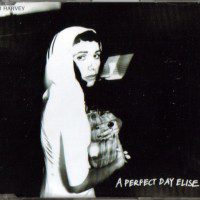It’s no secret that PJ Harvey has a bookish bent. She’s guest-designed an issue (PDF) of the literary magazine Zoetrope: All-Story and, as we discussed in an earlier PJ Harvey Tuesday, referenced T. S. Eliot. So it should come as no great surprise that her 1998 album Is This Desire? bites a few moves from literary sources. In particular, the first single, “A Perfect Day Elise,” takes its title and several of its lines from “A Perfect Day for Bananafish,” the first of the famous Glass family stories by yet another double-initialed author: J. D. Salinger. (Trivia buffs will note that the first track, “Angelene,” also steals a line from a Salinger story—”Pretty Mouth and Green My Eyes”—but the similarities more or less end there.)
Here’s how the Salinger story goes: A woman on vacation in Florida has a phone conversation with her mother, who disapproves of the woman’s husband because he keeps acting “funny” ever since returning from the war. Meanwhile, Seymour Glass, the husband, is out on the beach playing with a little girl named Sybil. He teases her about finding a “bananafish,” which he explains is a type of fish that swims into a hole and eats so many bananas it can’t fit back out and thus dies there. (He also quotes The Waste Land; PJ isn’t the only double-initialed Eliot admirer.) Sybil returns to her inattentive mother, and Seymour goes up to the hotel room where his wife is napping and “fire[s] a bullet through his right temple.”
Now take a moment to imagine that story as interpreted by a ’90s alt-rock video. Done? Then you’ve probably got a decently accurate idea of what’s coming:
Salinger’s ironically balmy Florida setting is replaced by a blighted, rocky beach, probably—let’s be honest—somewhere in England. The bourgeois assortment of hotel guests from the story is present, but here they’re washed out, blue-tinted, peering from behind crow’s feet into the middle distance.
The song’s lyrics, however, don’t hew terribly closely to the story. The names are changed, and the circumstances. Instead of a shell-shocked war veteran with a self-absorbed wife, the protagonist seems to be a man obsessed with “the girl in room 509,” even though he only “got lucky one time” before she told him, “Don’t you come here again.” There’s no innocent six-year-old, at least not obviously, and certainly no metaphorically gluttonous fictional fish.
Instead, Harvey uses a few Salinger lines and the general tone of the story as dots to connect in her own pattern—and naturally, that pattern involves brutally distorted bass and drums and an overcompressed vocal track that sounds like it was run through a guitar amp. The inescapable desperation and the climactic gunshot remain, but most of the rest of Salinger’s bleak depiction of post-war trauma has been converted to Harvey’s bleak depiction of modern love. It’s really a rather masterful way to meld inspiration and originality.




